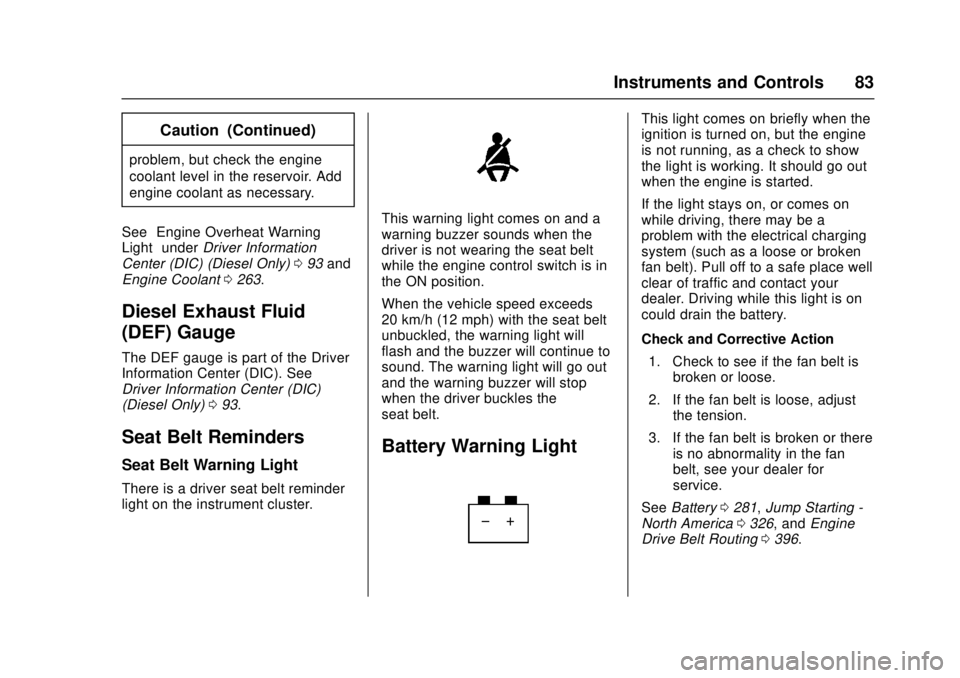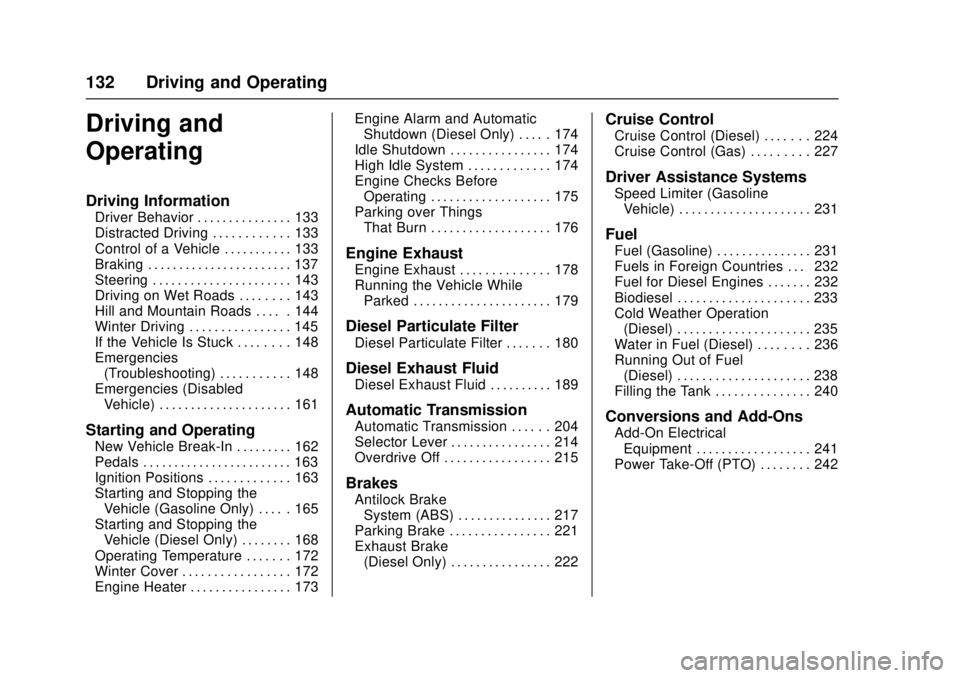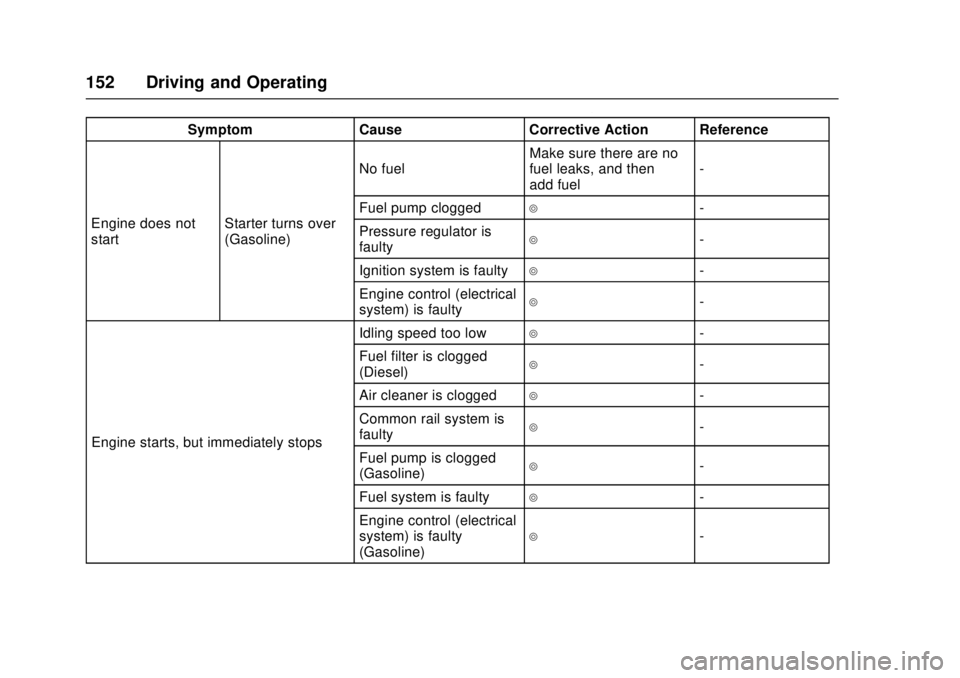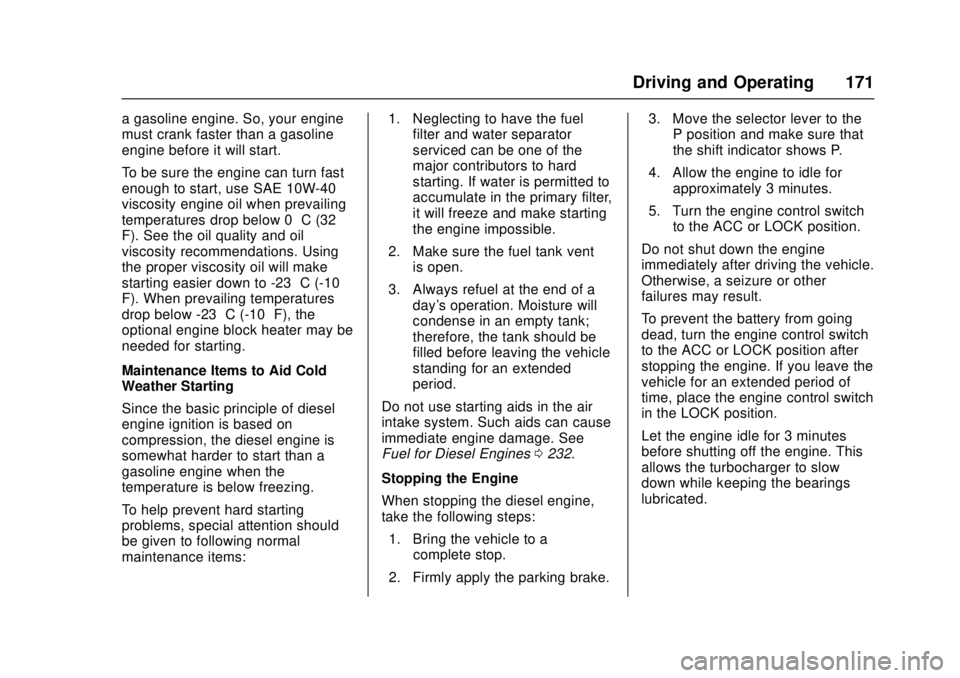ignition CHEVROLET LOW CAB FORWARD 2017 Owner's Manual
[x] Cancel search | Manufacturer: CHEVROLET, Model Year: 2017, Model line: LOW CAB FORWARD, Model: CHEVROLET LOW CAB FORWARD 2017Pages: 414, PDF Size: 7.97 MB
Page 84 of 414

Chevrolet Low Cab Forward Owner Manual (GMNA-Localizing-U.S.-
10716700) - 2017 - crc - 12/6/16
Instruments and Controls 83
Caution (Continued)
problem, but check the engine
coolant level in the reservoir. Add
engine coolant as necessary.
See “Engine Overheat Warning
Light” under Driver Information
Center (DIC) (Diesel Only) 093 and
Engine Coolant 0263.
Diesel Exhaust Fluid
(DEF) Gauge
The DEF gauge is part of the Driver
Information Center (DIC). See
Driver Information Center (DIC)
(Diesel Only) 093.
Seat Belt Reminders
Seat Belt Warning Light
There is a driver seat belt reminder
light on the instrument cluster.
This warning light comes on and a
warning buzzer sounds when the
driver is not wearing the seat belt
while the engine control switch is in
the ON position.
When the vehicle speed exceeds
20 km/h (12 mph) with the seat belt
unbuckled, the warning light will
flash and the buzzer will continue to
sound. The warning light will go out
and the warning buzzer will stop
when the driver buckles the
seat belt.
Battery Warning Light
This light comes on briefly when the
ignition is turned on, but the engine
is not running, as a check to show
the light is working. It should go out
when the engine is started.
If the light stays on, or comes on
while driving, there may be a
problem with the electrical charging
system (such as a loose or broken
fan belt). Pull off to a safe place well
clear of traffic and contact your
dealer. Driving while this light is on
could drain the battery.
Check and Corrective Action
1. Check to see if the fan belt is broken or loose.
2. If the fan belt is loose, adjust the tension.
3. If the fan belt is broken or there is no abnormality in the fan
belt, see your dealer for
service.
See Battery 0281, Jump Starting -
North America 0326, and Engine
Drive Belt Routing 0396.
Page 133 of 414

Chevrolet Low Cab Forward Owner Manual (GMNA-Localizing-U.S.-
10716700) - 2017 - crc - 12/6/16
132 Driving and Operating
Driving and
Operating
Driving Information
Driver Behavior . . . . . . . . . . . . . . . 133
Distracted Driving . . . . . . . . . . . . 133
Control of a Vehicle . . . . . . . . . . . 133
Braking . . . . . . . . . . . . . . . . . . . . . . . 137
Steering . . . . . . . . . . . . . . . . . . . . . . 143
Driving on Wet Roads . . . . . . . . 143
Hill and Mountain Roads . . . . . 144
Winter Driving . . . . . . . . . . . . . . . . 145
If the Vehicle Is Stuck . . . . . . . . 148
Emergencies(Troubleshooting) . . . . . . . . . . . 148
Emergencies (Disabled Vehicle) . . . . . . . . . . . . . . . . . . . . . 161
Starting and Operating
New Vehicle Break-In . . . . . . . . . 162
Pedals . . . . . . . . . . . . . . . . . . . . . . . . 163
Ignition Positions . . . . . . . . . . . . . 163
Starting and Stopping theVehicle (Gasoline Only) . . . . . 165
Starting and Stopping the Vehicle (Diesel Only) . . . . . . . . 168
Operating Temperature . . . . . . . 172
Winter Cover . . . . . . . . . . . . . . . . . 172
Engine Heater . . . . . . . . . . . . . . . . 173 Engine Alarm and Automatic
Shutdown (Diesel Only) . . . . . 174
Idle Shutdown . . . . . . . . . . . . . . . . 174
High Idle System . . . . . . . . . . . . . 174
Engine Checks Before Operating . . . . . . . . . . . . . . . . . . . 175
Parking over Things That Burn . . . . . . . . . . . . . . . . . . . 176
Engine Exhaust
Engine Exhaust . . . . . . . . . . . . . . 178
Running the Vehicle WhileParked . . . . . . . . . . . . . . . . . . . . . . 179
Diesel Particulate Filter
Diesel Particulate Filter . . . . . . . 180
Diesel Exhaust Fluid
Diesel Exhaust Fluid . . . . . . . . . . 189
Automatic Transmission
Automatic Transmission . . . . . . 204
Selector Lever . . . . . . . . . . . . . . . . 214
Overdrive Off . . . . . . . . . . . . . . . . . 215
Brakes
Antilock BrakeSystem (ABS) . . . . . . . . . . . . . . . 217
Parking Brake . . . . . . . . . . . . . . . . 221
Exhaust Brake (Diesel Only) . . . . . . . . . . . . . . . . 222
Cruise Control
Cruise Control (Diesel) . . . . . . . 224
Cruise Control (Gas) . . . . . . . . . 227
Driver Assistance Systems
Speed Limiter (GasolineVehicle) . . . . . . . . . . . . . . . . . . . . . 231
Fuel
Fuel (Gasoline) . . . . . . . . . . . . . . . 231
Fuels in Foreign Countries . . . 232
Fuel for Diesel Engines . . . . . . . 232
Biodiesel . . . . . . . . . . . . . . . . . . . . . 233
Cold Weather Operation(Diesel) . . . . . . . . . . . . . . . . . . . . . 235
Water in Fuel (Diesel) . . . . . . . . 236
Running Out of Fuel (Diesel) . . . . . . . . . . . . . . . . . . . . . 238
Filling the Tank . . . . . . . . . . . . . . . 240
Conversions and Add-Ons
Add-On Electrical Equipment . . . . . . . . . . . . . . . . . . 241
Power Take-Off (PTO) . . . . . . . . 242
Page 153 of 414

Chevrolet Low Cab Forward Owner Manual (GMNA-Localizing-U.S.-
10716700) - 2017 - crc - 12/6/16
152 Driving and Operating
SymptomCauseCorrective Action Reference
Engine does not
start Starter turns over
(Gasoline) No fuel
Make sure there are no
fuel leaks, and then
add fuel-
Fuel pump clogged
4-
Pressure regulator is
faulty
4-
Ignition system is faulty
4-
Engine control (electrical
system) is faulty
4-
Engine starts, but immediately stops Idling speed too low
4-
Fuel filter is clogged
(Diesel)
4-
Air cleaner is clogged
4-
Common rail system is
faulty
4-
Fuel pump is clogged
(Gasoline)
4-
Fuel system is faulty
4-
Engine control (electrical
system) is faulty
(Gasoline)
4-
Page 154 of 414

Chevrolet Low Cab Forward Owner Manual (GMNA-Localizing-U.S.-
10716700) - 2017 - crc - 12/6/16
Driving and Operating 153
SymptomCauseCorrective Action Reference
Unsteady engine speed (Diesel) There is water or air in
the fuel system
Drain water from fuel
filter or bleed the systemSee
Running Out
of Fuel (Diesel)
0 238 orWater in
Fuel (Diesel) 0236
Fuel system is faulty
4-
Unsteady engine speed (Gasoline) Fuel system is faulty
4-
Ignition system is faulty
4-
Engine control (electrical
system) is faulty
4-
Page 164 of 414

Chevrolet Low Cab Forward Owner Manual (GMNA-Localizing-U.S.-
10716700) - 2017 - crc - 12/6/16
Driving and Operating 163
.Use the lowest gear ratio
available when starting a loaded
vehicle and when climbing
slopes to avoid lugging the
engine.
. For vehicles with the 3.0L diesel
engine, It is recommended that
the engine speed is restricted to
2,400 r/min.
. For vehicles with the 5.2L diesel
engine, it is recommended that
the engine speed is restricted to
2,300 r/min.
Mechanical Driveshaft Brake
Burnish Procedure
It is recommended that the
driveshaft mounted parking brake
be burnished as part of the new
vehicle break-in procedure.
Increased parking brake
performance will result when the
parking brake is burnished as
specified below:
. Make 10 moderate stops, using
the hand brake, from 16 km/h
(10 MPH) while spacing the
stops a minimum of 4 km
(2.5 miles) apart. .
Operate the vehicle at 32 km/h
(20 MPH) between stops.
Pedals
Sit in a correct driving position on
the seat and operate the brake
pedal (1) and accelerator pedal (2)
with your right foot. To avoid
accidentally pressing the wrong
pedal, check the pedal positions
and practice putting your foot on the
desired pedal.
{Warning
A can or bottle rolling on the floor
may prevent brake pedal
operation if it is caught under the
pedal. This is very dangerous.
A floor mat must be placed
correctly. An incorrectly installed
floor mat may hinder the free
movement of each pedal. You
and others could be seriously
injured.
Ignition Positions
Engine Control Switch
{Warning
While driving, never turn the
engine control switch to the
LOCK position. The key could be
removed from the switch, which
then locks the steering wheel.
This is extremely dangerous.
You and others could be seriously
injured.
Page 167 of 414

Chevrolet Low Cab Forward Owner Manual (GMNA-Localizing-U.S.-
10716700) - 2017 - crc - 12/6/16
166 Driving and Operating
engine is running. If it stays on,
shut the engine off and find the
cause.
2. Look at the engine coolant temperature gauge. If the
gauge reaches the H (HOT)
area, stop the engine and find
the cause of the overheating.
3. Check that the battery warning light has gone out. The light
should go off and stay off at
normal idle speeds. If the light
does not go out or comes on
during normal operation, have
the charging system checked.
4. Check that the brake low vacuum warning light is out
and that the vacuum buzzer is
not sounding. It is normal for
the warning buzzer to sound
for a few seconds after the
engine starts. If the light and
buzzer remain on, do not drive
the vehicle until the cause has
been found and corrected.
5. Look at the brake system warning light. It should be out
when the parking brake is
released and the engine is running. If it stays on, it could
mean that the brake fluid level
is low. Check the brake fluid
reservoir. This condition must
be corrected before moving the
vehicle.
Caution
To reduce the chance of personal
injury and/or vehicle damage due
to engine overheating, never
leave the engine idling without an
alert driver present. If the engine
should overheat, as indicated by
the engine coolant temperature
gauge, immediate action is
required to correct the condition.
Continued operation of the
engine, even for a short time, may
result in a fire.
Starting the Engine
Do not keep the engine control
switch in the START position for
more than about 10 seconds.
Operating the starter for too long
might cause starter and battery
failure or may result in overheating. When the engine does not start,
wait for 20 to 30 seconds and then
turn the engine control switch again.
Before starting the engine sit in the
driver seat, check that the parking
brake is firmly engaged, the selector
lever is in the P or N (P is preferred)
position and the shift indicator also
shows P or N, and firmly press the
brake pedal to start the engine. See
Ignition Positions
0163.
{Warning
Do not keep the starter motor
engaged for more than
10 seconds at a time, or the
starter motor and the battery will
be adversely affected. Also, fire
may occur due to overheating.
Repeat the steps after a 20 to
30 seconds break.
1. Shift your selector lever to P (Park) or N (Neutral). Your
engine will not start in any
other position-that's a safety
Page 168 of 414

Chevrolet Low Cab Forward Owner Manual (GMNA-Localizing-U.S.-
10716700) - 2017 - crc - 12/6/16
Driving and Operating 167
feature. To restart when you're
already moving, use
N (Neutral) only.
Do not try to shift to P (Park) if
your vehicle is moving. If you
do, you could damage the
transmission. Shift to P (Park)
only when your vehicle is
stopped.
2. Do not push the accelerator pedal before starting your
engine. In some other vehicles
you might need to do this, but
because of your vehicle's
computer systems, you do not
need to.
3. Turn your ignition key to Start. When the engine starts, let go
of the key. The idle speed will
go down as your engine
gets warm.
4. If it does not start right away, hold your key in START. If it
doesn't start in 3 seconds,
push the accelerator pedal
about one-quarter of the way
down for 12 more seconds,
or until it starts. 5. If your engine still will not start
(or starts but then stops), it
could be flooded with too much
gasoline. Try this: Wait 20 to
30 seconds to let the starter
motor cool down. Then push
your accelerator pedal all the
way to the floor. Hold it there.
Then, hold the key in START
for no more than 10 seconds.
This clears the extra gasoline
from the engine.
If the engine still does not start, wait
another 20 to 30 seconds and do
Step 5 again.
Hot Engine Restart
If your engine is already hot and
then stalls, turn your ignition key to
ACC. Then, turn your key to ON,
and wait about 20 to 30 seconds
before you restart your engine.
When the engine starts, let go of the
key and the accelerator pedal.
Your engine is designed to work
with the electronics in your vehicle.
If you add electrical parts or
accessories, you could change the
way the fuel injection system operates. Before adding electrical
equipment, check with your dealer.
If you do not, your engine might not
perform properly.
If you ever have to have your
vehicle towed, see the part of this
manual that tells how to do it without
damaging your vehicle. See
Towing
the Vehicle 0332.
Recommendations for Warming
Up the Engine
The engine is sufficiently warmed
up when the needle of the engine
coolant temperature gauge starts
to move.
. Do not race the engine or
quickly accelerate before the
engine has sufficiently warmed
up. Oil would not have
adequately reached and
lubricated components, and a
breakdown may result.
. The exhaust pipe becomes
extremely hot while the engine is
idling. Before warming up the
engine, make sure there is no
Page 170 of 414

Chevrolet Low Cab Forward Owner Manual (GMNA-Localizing-U.S.-
10716700) - 2017 - crc - 12/6/16
Driving and Operating 169
Sit behind the wheel, adjust the seat
position, and buckle up the seat
belt. The passengers are also
required to buckle up the seat belts.
Adjust the positions of the steering
wheel and mirrors. Lock the doors.
Turn the power of the dome light or
accessories OFF before starting the
engine. SeeSeat Position 044,
Seat Belts 049, Steering Wheel
Adjustment 072, and Mirrors039.
Keep the Floor Around the
Driver's Seat Clean and Tidy
{Warning
It is extremely dangerous to have
empty cans, empty bottles or
other items rolling around on the
floor because they could get
trapped under the brake pedal
and prevent brake application.
For proper pedal operation, it is
also essential to lay floor mats
properly. Incorrectly installed floor
mats would hinder free movement
of the pedals. (Continued)
Warning (Continued)
Do not use the dashboard pocket
or the top of the dashboard as a
place to put items that could roll,
which could interfere with your
driving. You and others could be
seriously injured.
Choose Your Footwear Suitable
for Driving
{Warning
Choose footwear that ensures
proper operation of pedals when
driving the vehicle. Use of
footwear unsuitable for driving
may cause an accident.
Starting the Engine
Do not keep the engine control
switch in the START position for
more than about 10 seconds.
Operating the starter for too long
might cause starter and battery
failure or may result in overheating. When the engine does not start,
wait for 20 to 30 seconds and then
turn the engine control switch again.
Before starting the engine sit in the
driver seat, check that the parking
brake is firmly engaged, the selector
lever is in the P or N (P is preferred)
position and the shift indicator also
shows P or N, and firmly press the
brake pedal to start the engine.
When stopped on a slope, start the
engine with the selector lever in the
P position. See
Ignition Positions
0 163.
1. Make sure that the selector lever is in the P or N position
and firmly press the brake
pedal.
2. When the engine control switchis turned to the ON position,
the wait-to-start light comes on
and it goes out in about
Page 172 of 414

Chevrolet Low Cab Forward Owner Manual (GMNA-Localizing-U.S.-
10716700) - 2017 - crc - 12/6/16
Driving and Operating 171
a gasoline engine. So, your engine
must crank faster than a gasoline
engine before it will start.
To be sure the engine can turn fast
enough to start, use SAE 10W-40
viscosity engine oil when prevailing
temperatures drop below 0 °C (32 °
F). See the oil quality and oil
viscosity recommendations. Using
the proper viscosity oil will make
starting easier down to -23 °C (-10 °
F). When prevailing temperatures
drop below -23 °C (-10 °F), the
optional engine block heater may be
needed for starting.
Maintenance Items to Aid Cold
Weather Starting
Since the basic principle of diesel
engine ignition is based on
compression, the diesel engine is
somewhat harder to start than a
gasoline engine when the
temperature is below freezing.
To help prevent hard starting
problems, special attention should
be given to following normal
maintenance items:1. Neglecting to have the fuel
filter and water separator
serviced can be one of the
major contributors to hard
starting. If water is permitted to
accumulate in the primary filter,
it will freeze and make starting
the engine impossible.
2. Make sure the fuel tank vent is open.
3. Always refuel at the end of a day's operation. Moisture will
condense in an empty tank;
therefore, the tank should be
filled before leaving the vehicle
standing for an extended
period.
Do not use starting aids in the air
intake system. Such aids can cause
immediate engine damage. See
Fuel for Diesel Engines 0232.
Stopping the Engine
When stopping the diesel engine,
take the following steps: 1. Bring the vehicle to a complete stop.
2. Firmly apply the parking brake. 3. Move the selector lever to the
P position and make sure that
the shift indicator shows P.
4. Allow the engine to idle for approximately 3 minutes.
5. Turn the engine control switch to the ACC or LOCK position.
Do not shut down the engine
immediately after driving the vehicle.
Otherwise, a seizure or other
failures may result.
To prevent the battery from going
dead, turn the engine control switch
to the ACC or LOCK position after
stopping the engine. If you leave the
vehicle for an extended period of
time, place the engine control switch
in the LOCK position.
Let the engine idle for 3 minutes
before shutting off the engine. This
allows the turbocharger to slow
down while keeping the bearings
lubricated.
Page 303 of 414

Chevrolet Low Cab Forward Owner Manual (GMNA-Localizing-U.S.-
10716700) - 2017 - crc - 12/6/16
302 Vehicle Care
No. Description Rating16 MIRROR HEATER 15A
17 IGNITION 2 10A
18 IGNITION 1 10A
19 – –
20 ECM 10A
21 METER 10A
22 ECU (BATT) 10A
23 MIRROR 10A
24 AUDIO, ACC 15A
25 HORN 15A
26 TURN, HAZARD 15A
27 TAIL LAMPS 10A
28 ILLUMI- NATIONS 10A
29 CORNERING LAMPS 10A
30 AIR COND- ITIONER 10A
31 – –
32 – – No. Description Rating
33 – –
34 – –
D-1 CIGAR 20A
D-2 ACCES- SORIES
SOCKET 15A
D-3 POWER SOURCE 20A
D-4 – –